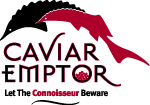

The International Caviar Trade
Commercial fishermen have hunted sturgeon for their roe and meat since at least 1100 BC. Ancient Greek and Roman literature refers to caviar, and the Chinese were trading it as early as the 10th century AD.
Today, the majority of caviar produced is sold on the international market. Under international labeling rules, only sturgeon eggs can carry the caviar label. Imported caviar sells for $100 an ounce or more in the United States.
The United States imports about one-third of the world's total caviar imports. From 1989 to 1997, the United States imported an average of 130,000 pounds of caviar per year, worth about $6.6 million. Caviar from the three principal Caspian Sea sturgeon species -- beluga, Russian and stellate -- dominates the U.S. caviar market. Until last spring, when U.S. trade sanctions against Iran were lifted for caviar, Russia supplied virtually all of the caviar imported into the United States.
Based on figures reported to the United Nations Food and Agriculture Organization, the United States has produced up to 5 percent of the world's total sturgeon (both meat and eggs) since 1982. Nearly all of it in recent years has come from aquaculture and inland freshwater fisheries for paddlefish, shovelnose sturgeon, and white sturgeon. This figure is at best a rough estimate -- and likely an underestimate -- because some countries, including the United States, do not have rigorous programs to collect sturgeon fishery landings and aquaculture production information. Aquaculture of sturgeon and paddlefish for caviar is increasing in the United States and abroad, bringing with it both conservation opportunities and problems as discussed later in this report.
The Convention on the International Trade in Endangered Species (CITES)
Increasing concern about the status of Caspian Sea sturgeon inspired international action in 1998 to regulate the caviar trade by listing all previously unlisted sturgeon species under Appendix II of the Convention on the International Trade in Endangered Species (CITES). Now, caviar exports must be accompanied by a CITES export permit issued by a designated management agency in the country of export. A separate "Scientific Authority" in the exporting country must determine that commercial trade is not detrimental to the survival of the species in the wild. Currently all but one (Turkmenistan) of the Caspian Sea border nations are parties to the CITES convention and thus bound by the new requirements. And some countries have implemented additional protections: the European Union, for example, requires an import permit for all Appendix II-listed species.
In 2000, countries that are bound by CITES adopted a resolution requiring that exported caviar must carry a non-reusable label that includes identification of the grade (beluga, sevruga, osetra), the country of origin, the year of catch and an identifying number. These labels are required only for the initial export of caviar, not the re-export. CITES member nations may also accept shipments of caviar imported directly from countries of origin only if they are accompanied by appropriate documents and labels. The resolution further requires parties to establish a system of registration or licensing for both exports and imports.
Significant quantities of poached caviar are exported -- indeed, smuggling such caviar out of the five countries bordering the Caspian Sea is a flourishing business. Russia officially exported $25 million worth of caviar in 1999, while the value of poached caviar exports was estimated at $250 million. Discrepancies between trade statistics of countries importing and exporting caviar can indicate illegal trade. For example, Turkish caviar exports in 1996 totaled 121 tons, even though that country's sturgeon catch has been limited to a few incidental catches since the late 1980s.
Russia reportedly plans to introduce a state monopoly on caviar production in 2001 to help reduce illegal trade.
Caviar smuggling into the United States is routine. According to the U.S. Fish and Wildlife Service, illegally imported caviar is seized virtually every week at New York's JFK Airport. Since April, 1998, 167 seizures have yielded 31,000 pounds of caviar smuggled into the United States.
In the first case of enforcement of CITES requirements in the United States, a major caviar importer was sentenced in 2000 to 20 months in a federal prison and fined $25,000 for smuggling, conspiracy, and violating the Lacey Act, a federal law protecting wildlife taken, transported or sold in violation of any U.S. law or treaty. Warsaw's deputy police chief at the time pleaded guilty to conspiracy to smuggle wildlife. The company's records revealed sales of 21,000 pounds of caviar during a seven-month period; only 88 pounds of caviar had been legally imported.
In July, 2000, Maryland-based U.S. Caviar and Caviar Ltd. was fined $10.4 million -- the largest fine ever in a wildlife prosecution -- for smuggling black market Russian caviar into the United States using forged Russian caviar labels, and for passing caviar from American paddlefish and shovelnose sturgeon as Russian caviar. Company officials admitted selling the contraband caviar to victim airlines, caviar wholesalers, seafood suppliers, and gourmet stores.
While new CITES labeling requirements will help, illegal trade via smuggling, falsely produced labels and other means will likely continue as long as demand fuels very high prices. In addition, CITES actions do not affect domestic consumption of caviar within Caspian Sea countries. Despite the controls placed on the sale and trade of sturgeon products, illegally obtained sturgeon meat and caviar are openly available in Russia; the main difference between the legal and illegal caviar is the price, with illegal caviar costing less than half the price of legal caviar.
Home | Q and A | Table of Contents
